 Un alimento en puré es un alimento que ha sido licuado, mesclado o procesado hasta crear una textura uniforme y suave. Los ejemplos de alimentos con una consistencia en puré incluyen la salsa de manzana, relleno de tarta de calabaza y humus. Los alimentos en puré pueden ser necesarios para personas con problemas al tragar y/o masticar. Para aquellos que requieren una dieta basada de purés, es muy importante proveer una variedad de alimentos. Casi todas las comidas se pueden preparar como puré. Sin embargo, algunas comidas pueden ser más aceptadas que otras. This 4-page fact sheet was written by Wendy J. Dahl y Jamila R. Lepore, and published by the UF Department of Food Science and Human Nutrition, February 2014.
Un alimento en puré es un alimento que ha sido licuado, mesclado o procesado hasta crear una textura uniforme y suave. Los ejemplos de alimentos con una consistencia en puré incluyen la salsa de manzana, relleno de tarta de calabaza y humus. Los alimentos en puré pueden ser necesarios para personas con problemas al tragar y/o masticar. Para aquellos que requieren una dieta basada de purés, es muy importante proveer una variedad de alimentos. Casi todas las comidas se pueden preparar como puré. Sin embargo, algunas comidas pueden ser más aceptadas que otras. This 4-page fact sheet was written by Wendy J. Dahl y Jamila R. Lepore, and published by the UF Department of Food Science and Human Nutrition, February 2014.
http://edis.ifas.ufl.edu/fs246
Tag: Jamila R. Lepore
Alimentos en pure: Los pures altos en proteina
 La proteína es un nutriente esencial que nuestro cuerpo necesita para funcionar correctamente y de manera eficiente. Cada célula, tejido y órgano del cuerpo necesita una fuente constante de proteínas para mantener una buena salud y un buen funcionamiento. Para que estos procesos metabólicos ocurran, las proteínas se descomponen para que el cuerpo las pueda usar y se reemplazan por los alimentos que comemos. This 5-page fact sheet was written by Jamila R. Lepore y Wendy J. Dahl, and published by the UF Department of Food Science and Human Nutrition, February 2014.
La proteína es un nutriente esencial que nuestro cuerpo necesita para funcionar correctamente y de manera eficiente. Cada célula, tejido y órgano del cuerpo necesita una fuente constante de proteínas para mantener una buena salud y un buen funcionamiento. Para que estos procesos metabólicos ocurran, las proteínas se descomponen para que el cuerpo las pueda usar y se reemplazan por los alimentos que comemos. This 5-page fact sheet was written by Jamila R. Lepore y Wendy J. Dahl, and published by the UF Department of Food Science and Human Nutrition, February 2014.
http://edis.ifas.ufl.edu/fs245
MiPlato para los problemas de deglucion: Disfagia (FSHN1214S/FS223)
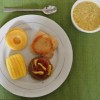 MiPlato es el ícono de los lineamientos alimentarios del Departamento de Agricultura de los Estados Unidos basado en las Guías Alimentarias del 2010 para los Estadounidenses. Es una imagen fácil de entender que se enfoca en la creación de un plato con alimentos saludables. Los recursos y herramientas en ChooseMyPlate.gov ofrece información clara y factible acerca de cómo escoger mejor alimentos que se pueden adaptar a personas con dificultades de deglución (disfagia) que requieren de alimentos con textura modificada. Aunque los alimentos magros y los alimentos bajos en grasa son recomendados, aquellos con dificultades de deglución pueden necesitar añadir la grasa a algunos alimentos para mejorar la aceptabilidad, la facilidad de deglución y también para ayudarlos a satisfacer sus necesidades de energía. This 3-page fact sheet was written by Jamila R. Lepore, Nancy J. Gal, and Wendy Dahl, and published by the UF Department of Food Science and Human Nutrition, April 2013.
MiPlato es el ícono de los lineamientos alimentarios del Departamento de Agricultura de los Estados Unidos basado en las Guías Alimentarias del 2010 para los Estadounidenses. Es una imagen fácil de entender que se enfoca en la creación de un plato con alimentos saludables. Los recursos y herramientas en ChooseMyPlate.gov ofrece información clara y factible acerca de cómo escoger mejor alimentos que se pueden adaptar a personas con dificultades de deglución (disfagia) que requieren de alimentos con textura modificada. Aunque los alimentos magros y los alimentos bajos en grasa son recomendados, aquellos con dificultades de deglución pueden necesitar añadir la grasa a algunos alimentos para mejorar la aceptabilidad, la facilidad de deglución y también para ayudarlos a satisfacer sus necesidades de energía. This 3-page fact sheet was written by Jamila R. Lepore, Nancy J. Gal, and Wendy Dahl, and published by the UF Department of Food Science and Human Nutrition, April 2013.
http://edis.ifas.ufl.edu/fs223
Carbohydrate Counting: Meals for Diabetes (FSHN1218/FS212)
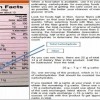 “Carb” counting is a way to plan meals to help you maintain target blood glucose levels. Certain foods contain carbohydrate, and these are the foods that most influence your blood glucose. Your body needs carbohydrate in just the right amount. Not enough carbohydrate can lead to low blood glucose (hypoglycemia). Too much carbohydrate can lead to high blood glucose (hyperglycemia). This is why carb counting is a great tool to understand and practice because it can help you control your blood glucose and still give you the freedom to make varied food choices. This 4-page fact sheet was written by Cassie Rowe, Jamila R. Lepore, and Wendy J. Dahl, and published by the UF Department of Food Science and Human Nutrition, March 2013.
“Carb” counting is a way to plan meals to help you maintain target blood glucose levels. Certain foods contain carbohydrate, and these are the foods that most influence your blood glucose. Your body needs carbohydrate in just the right amount. Not enough carbohydrate can lead to low blood glucose (hypoglycemia). Too much carbohydrate can lead to high blood glucose (hyperglycemia). This is why carb counting is a great tool to understand and practice because it can help you control your blood glucose and still give you the freedom to make varied food choices. This 4-page fact sheet was written by Cassie Rowe, Jamila R. Lepore, and Wendy J. Dahl, and published by the UF Department of Food Science and Human Nutrition, March 2013.
http://edis.ifas.ufl.edu/fs212
Pureed Foods: High Protein (FSHN1215/FS208)
 Protein is an important nutrient. Many older adults do not consume enough of this vital nutrient, crucial to overall health and well-being. For those with dysphagia and on a puréed diet, consuming sufficient protein is even more difficult. While a texture-modified diet may not be the diet of choice, the goal is to make it as appealing as possible so that the person consuming the purées can experience a better quality of life. This 4-page fact sheet was written by Jamila R. Lepore and Wendy J. Dahl, and published by the UF Department of Food Science and Human Nutrition, March 2013.
Protein is an important nutrient. Many older adults do not consume enough of this vital nutrient, crucial to overall health and well-being. For those with dysphagia and on a puréed diet, consuming sufficient protein is even more difficult. While a texture-modified diet may not be the diet of choice, the goal is to make it as appealing as possible so that the person consuming the purées can experience a better quality of life. This 4-page fact sheet was written by Jamila R. Lepore and Wendy J. Dahl, and published by the UF Department of Food Science and Human Nutrition, March 2013.
http://edis.ifas.ufl.edu/fs208
Preparation of Pureed Foods (FSHN1212/FS205)
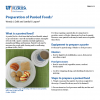 A puréed food is a food item that has been blended, mixed, or processed into a smooth and uniform texture. Examples of foods with a purée consistency include applesauce, pumpkin pie filling, and hummus. Puréed foods may be necessary for people with chewing and/or swallowing problems. For those requiring a puréed diet, it is important to provide a variety of foods. Almost any food can be puréed. However, some puréed foods may be much more acceptable than others. This 4-page fact sheet was written by Wendy J. Dahl and Jamila R. Lepore, and published by the UF Department of Food Science and Human Nutrition, March 2013.
A puréed food is a food item that has been blended, mixed, or processed into a smooth and uniform texture. Examples of foods with a purée consistency include applesauce, pumpkin pie filling, and hummus. Puréed foods may be necessary for people with chewing and/or swallowing problems. For those requiring a puréed diet, it is important to provide a variety of foods. Almost any food can be puréed. However, some puréed foods may be much more acceptable than others. This 4-page fact sheet was written by Wendy J. Dahl and Jamila R. Lepore, and published by the UF Department of Food Science and Human Nutrition, March 2013.
http://edis.ifas.ufl.edu/fs205
MyPlate for Dysphagia (FHSN1214/FS207)
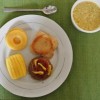 Resources and tools at ChooseMyPlate.gov that provide clear, actionable information about how to make better food choices can be easily adapted for persons with swallowing difficulties (dysphagia) that require texture-modified foods. This 3-page fact sheet was written by Jamila R. Lepore, Nancy Gal, and Wendy J. Dahl, and published by the UF Department of Food Science and Human Nutrition, December 2012.
Resources and tools at ChooseMyPlate.gov that provide clear, actionable information about how to make better food choices can be easily adapted for persons with swallowing difficulties (dysphagia) that require texture-modified foods. This 3-page fact sheet was written by Jamila R. Lepore, Nancy Gal, and Wendy J. Dahl, and published by the UF Department of Food Science and Human Nutrition, December 2012.
http://edis.ifas.ufl.edu/fs207
Sensory Acceptability of Pureed Foods (FSHN1213/FS206)
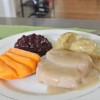 It is important that we enjoy the food we eat. This makes for a better quality of life. This is no different for those people needing to be on puréed diets due to swallowing problems. And just like you wouldn’t want to serve guests a recipe without trying it first, you don’t want to serve a puréed food without knowing that it is appealing. This 5-page fact sheet was written by Jamila R. Lepore and Wendy J. Dahl, and published by the UF Department of Food Science and Human Nutrition, November 2012.
It is important that we enjoy the food we eat. This makes for a better quality of life. This is no different for those people needing to be on puréed diets due to swallowing problems. And just like you wouldn’t want to serve guests a recipe without trying it first, you don’t want to serve a puréed food without knowing that it is appealing. This 5-page fact sheet was written by Jamila R. Lepore and Wendy J. Dahl, and published by the UF Department of Food Science and Human Nutrition, November 2012.
http://edis.ifas.ufl.edu/fs206
La aceptabilidad sensorial de los alimentos en pure (FSHN1213S/FS216)
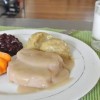 La evaluación sensorial es el proceso en el que utilizamos nuestros sentidos (gusto, olfato, tacto, vista) y su aplicación para la determinación de la aceptabilidad de los alimentos. ¡Simplemente, se están evaluando los alimentos para asegurarse que se ven, huelen y saben delicioso! This 6-page fact sheet was written by Jamila R. Lepore and Wendy J. Dahl, and published by the UF Department of Food Science and Human Nutrition, December 2012.
La evaluación sensorial es el proceso en el que utilizamos nuestros sentidos (gusto, olfato, tacto, vista) y su aplicación para la determinación de la aceptabilidad de los alimentos. ¡Simplemente, se están evaluando los alimentos para asegurarse que se ven, huelen y saben delicioso! This 6-page fact sheet was written by Jamila R. Lepore and Wendy J. Dahl, and published by the UF Department of Food Science and Human Nutrition, December 2012.
http://edis.ifas.ufl.edu/fs216